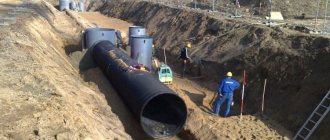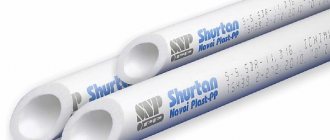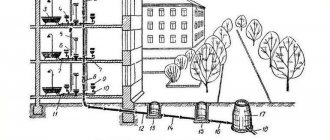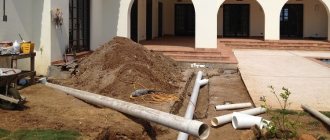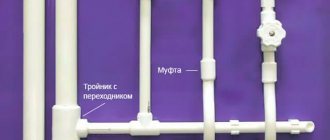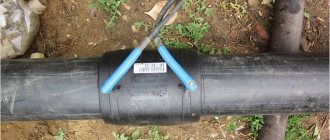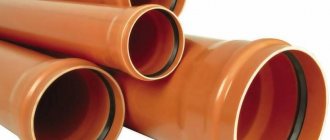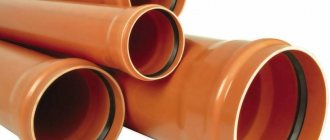Repairing old and laying new water supply networks in residential premises begins with calculating the cost of the work. However, not only the price of pipes plays a decisive role. Equally important is the material from which they are made, the installation method and the ability to carry out work without the involvement of specialized specialists.
In the process of selecting water pipes for a residential premises, one should take into account possible future repairs or replacement of individual components in the event of emergency situations. Based on this, you need to focus on cost, quality and technical characteristics, which must meet all the necessary requirements.
Types of water pipes
Modern manufacturers of water fittings offer consumers two main types of water pipes:
- Non-metallic; Metallic.
Products of both types differ in technical characteristics, material, performance properties and chemical composition. Based on these signs, certain options for hot or cold water are selected.
Non-metallic pipes are made from the following materials:
- polypropylene; polyethylene; metal-plastic; PVC.
The following metals and alloys are used to produce the main types of metal pipes:
- steel;stainless steel;copper.
The main factor contributing to the widespread use of non-metallic water pipes is their durability and low cost. Scale and rust do not form on the inner walls of plastic products.
Their service life can exceed half a century, and installation and repair are much cheaper than metal analogues. Moreover, servicing or replacing a plastic water pipe does not require welding, which means any homeowner can do it if they have some experience and tools.
How to choose pipes for water supply according to operating conditions
Communications that are installed indoors are also called wiring. The main task of water pipes is to deliver water to plumbing fixtures and other equipment. The correct selection of materials depends on the operating conditions and characteristics of a particular communication.
Note! Products made from various modern polymer materials, namely polypropylene (PP), polyethylene (PE), polyvinyl chloride (PVC), polybutylene (PB) and metal polymers, as a rule, have operational limitations. These limitations vary depending on your specific conditions of use.
In turn, some metal elements of pipeline structures can be used with virtually no restrictions. Such products include: galvanized steel, stainless steel, copper, bronze and brass. Plumbing lines made from these materials can be used to transport hot and cold water under high pressure. In addition, such materials are excellent for organizing communications at various enterprises that require process water.
Plastic products can be mounted in special channels or under baseboards. This will not only improve the appearance of the room, but also protect communications from mechanical damage, which is very important, since the strength of such pipes is quite low. There are also special flexible pipes called hoses. Such liners are allowed to be installed openly in safe places (for example, behind a toilet cistern).
Each type of these products has limitations on the pressure they can withstand. The selection of parts for a specific system is carried out taking into account the pressure in it. In this case, it is recommended to select pipes with a maximum pressure value that exceeds the maximum pressure in the system.
Pipes are selected taking into account the purpose of the future system and the pressure in it
Let's consider a few more tips on choosing a pipeline for transporting water, depending on operational features:
- in houses where there is a centralized water supply, pressure readings can vary from 2.5–7.5 bar. The peak value in this case can reach 10 bar, and if communication is being checked - 12 bar. In this regard, it is recommended to provide a certain safety margin when choosing water pipes;
- the main factor that should be taken into account when choosing water supply elements for open (above-ground) installation on the street is the coefficient of ring stiffness;
- if the polymer pipeline will be laid in the soil, without using a protective channel, it is advisable to choose products equipped with a special protective coating.
Polypropylene
This type of product is characterized by increased strength and durability. Polypropylene pipes used for hot water supply will surely last 25 years or more, and for cold water supply - over 50. The material is very light, which has a positive effect on ease of installation and transportation.
An important positive property is the invariability of the characteristics of polypropylene, even with sharp temperature fluctuations and freezing of water.
When installing polypropylene water pipes, fittings are used at bending points. Due to the increased rigidity of the material, bending it in the usual way is unacceptable.
Communications for gravity networks
Almost all discharge pipelines operate under natural pressure of one atmosphere. After all, to drain the used liquid, you only need a slope and the force of gravity. Therefore, communications for non-pressure pipelines are made from materials that are unable to withstand serious internal loads.
Among metals, such materials include various types of cast iron - an iron-carbon alloy, which is characterized by a combination of high hardness and brittleness.
The first quality - hardness - allows us to make quite durable products from cast iron that can resist corrosive processes for 60-80 years. The second quality - fragility - forces you to handle cast iron products very carefully. After all, they can burst even from any blow from a hard object.
However, cast iron pipes are the “yesterday” of plumbing systems. All modern non-pressure networks are assembled only from plastic components. PVC pipes are used as the basis for internal (home) lines - such products have the thinnest wall, therefore, they take up less space. Well, as a basis for the external (yard) line they use two-layer polyethylene products, which have good plasticity, therefore, they are not afraid of freezing or movement of soil layers.
However, despite the different materials and different characteristics, all free-flow pipes have two similar features:
- Firstly, such pipes are quite large in size.
- Secondly, the installation of such pipes is carried out using identical technology.
Non-pressure plumbing pipes - product dimensions
The classic sizes of plumbing pipes are 50 and 110 millimeters in diameter. Moreover, plumbing pipes with a diameter of 50 mm (along the outer section) are used to drain water from sinks and drains of shower stalls or bathtubs, and 110 mm pipes are used to drain water from a toilet or to collect all drains from 50 mm products.
However, the size range of non-pressure pipes also includes other products. Thus, the dimensions of the cast iron pipe range range between 50 and 150 millimeters. But PVC and PE pipes are characterized by more impressive dimensions: from 50 to 1200 millimeters.
The huge sizes of plastic plumbing pipes (from 315 mm) are justified only in the process of arranging external industrial networks.
Installation and replacement of non-pressure plumbing pipes
The assembly of non-pressure networks involves the use of a fairly simple joining method - into a socket. This technology is based on arranging a special thickening at the end of the pipe - a bell, ready to accept the smooth part of the next product. In this case, all corner junctions and joining points of pipes in the line are arranged using special elements - fittings, at the ends of which there is the same socket.
And the installation itself, in this case, is carried out by placing the smooth part of the pipe (fitting) in the socket. Well, the joints are sealed using an O-ring placed in the socket.
A rubber ring is mounted in polymer pipes, and a special oiled rope – a heel – is minted (pushed) into the cast iron sockets.
Replacing a pipe in a non-pressure pipeline is very simple - the damaged section is removed from the socket. The O-rings do not interfere with dismantling at all. Difficulties can only arise with a heel. For any plumber, replacing cast iron pipes is a real punishment: after all, caulking a joint in a cast iron pipeline is a very dirty and labor-intensive operation.
Polyethylene
Water pipes made from this material are highly reliable due to their ability to withstand pressure up to 16 atmospheres. Despite many positive aspects, polyethylene products are not widely used.
The temperature range in which they can be operated is from -40 C to +40 C. Given the low heat resistance, coupled with a fairly large linear expansion rate, such a water supply may not always be a suitable option for the home.
However, cross-linked polyethylene, which appeared on the market not so long ago, turned out to be more in demand. Installation of a water supply system made of such material is as simple and convenient as possible. At the joints, fittings without rubber seals are used, and a special fitting is installed on top of them.
The undeniable advantages of a polyethylene plumbing unit include:
- increased strength; resistance to low temperatures; inertness to many chemicals present in water; fittings used for installation do not interfere with permeability.
The product has a multilayer design, in which the outer and inner layers are made of plastic, and the middle is made of metal. This results in increased strength with low weight.
The elasticity inherent in metal-plastic pipes allows them to be given various shapes. Positive properties include excellent thermal conductivity of the product, easy and convenient installation.
Vulnerable places in a metal-plastic water supply are connections. When carrying out work, you need to pay increased attention to the quality of installation of fittings. The fact is that with sudden temperature changes, aluminum contracts faster than plastic and high pressure in the system can lead to an emergency.
Connection methods
- What fittings and adapters for water supply pipes are used when installing water pipelines?
| Image | Description |
| Black steel pipes are mounted on bends and tees for welding (electric and gas) or on threaded connections. |
| Galvanized steel is connected only with threads. The instruction is related to the limited heat resistance of the anti-corrosion coating: if steel melts at 1400 degrees, then zinc evaporates at 900. |
| Copper pipes are connected using solder fittings, as well as compression fittings (with union nuts and ferrules) and press fittings. |
| The corrugated stainless steel pipe is mounted on compression fittings and on connections with rolling and union nuts. |
| Metal-plastic: compression and press fittings. The former compress the pipe onto the fitting with a split ring while tightening the union nut, the latter use for this purpose a stainless steel sleeve deformed by pliers. |
| Polyethylene: for wall thicknesses of 4 mm or more, butt welding is used; for smaller thicknesses, electric welding (with its own heating coil) and compression fittings are used. |
| PEX: Slide sleeve fittings (using pipe shape memory) and compression connectors are used. |
| PERT and polypropylene: the main installation method is low-temperature sleeve welding. Polypropylene pipes reinforced with aluminum foil are stripped of the reinforcing layer before installing the fitting connection. |
| PVC: water supply is mounted on adhesive joints and on sockets with ring rubber seals. |
PVC
Pipes made of polyvinyl chloride are in many ways superior to their plastic counterparts in strength and resistance to aggressive chemicals, and the permissible pressure in such a water supply can reach 46 atmospheres.
Resistance to high temperatures allows the use of polyvinyl chloride water supply for hot water supply. It confidently withstands temperatures up to 90 degrees Celsius.
Installation does not cause any particular difficulties and you can do all the work with PVC water supply yourself without welding. The process requires only couplings and angles, which makes installation cheaper compared to analogues for which it is necessary to purchase fittings.
Metal pipes have been used for decades. Despite the emergence of new materials, they still have not lost their relevance. Metal, like plastic, has its pros and cons.
The biggest advantage of metal water pipes is mechanical strength. However, its service life is only a few years. In addition, complex installation and welding work increases installation and maintenance costs.
During operation, growths form on the walls of a metal water pipeline, which lead to a drop in pressure and throughput.
Polymer pipes
The revolution in the chemical industry was marked by the emergence of new materials in construction. Various types of polymer water pipes are made from thermoplastics or thermosets:
- polyethylene PE;
- polyvinyl chloride PVC;
- polypropylene PP;
- polyamide PA;
- polybutylene PB;
- fiberglass;
- fiberglass;
- epoxy or polyester.
The diameter of polyethylene pressure profiles is 16-1600 mm. The wall thickness is designed to withstand operating pressures of 4-20 bar. Products with a cross-section of up to 40 mm are used for home plumbing, and up to 160 for risers or sewers. Large sizes are used in manufacturing.
Polyethylene profile
Polyethylene pipes are marked by density - from 63 to 100 (kg/m³). Less dense materials are mechanically unstable. Non-pressure structures are made from them - summer showers, irrigation, sewer drains. PE 80 is stronger, they are used to install cold pipelines inside the house. PE 100 is used to supply hot water and heating.
Polyethylene pipelines are mounted using compression or thermistor fittings, butt welding.
Connection with fittings
External water supply is laid from polyvinyl chloride pipes. They are gray in color and are available in lengths of 1, 2, 3 and 6 m. The nominal diameter of the products is 90-500 mm. Designed for pressure 6-16 bar. They are mounted without couplings or welding. At one end there is a socket with an o-ring seal, into which the other part of the round profile is inserted. The connection is completely sealed and can withstand regulatory loads.
Advantages of polymer pipes:
- resistance to chemical and electrical corrosion, exposure to aggressive environments;
- harmlessness, absence of harmful secretions into the transported liquid;
- smoothness of the inner surface on which dirt does not linger;
- low thermal conductivity, reducing energy losses and condensation formation;
- low weight and plasticity, which simplifies transportation and installation;
- poor sound permeability, reducing the noise level when passing water.
During reconstruction, the system can be easily remade by cutting the communications and connecting a new branch using a fitting. The construction of water supply systems made of polymer pipes is 30-40% cheaper than a similar one made of steel.
Disadvantages of products that are common to all plastics:
- instability to ultraviolet radiation;
- high coefficient of linear thermal expansion;
- brittleness at low temperatures;
- most of them do not burn, but support combustion and emit harmful substances;
- restrictions on operating pressure and temperature.
The most heat-resistant pipes are made from cross-linked polyethylene PEX, which is produced under high pressure. Used for cold and hot water supply. Withstands temperatures up to +95° and pressure up to 20 atm.
Which pipes to choose for water supply (video)
The disadvantages of such water pipes include heavy weight, complex installation and corrosion. However, modern manufacturers have learned to coat the inner surface with a non-metallic layer, which increases the service life of the product and avoids corrosion.
Stainless steel products are superior to conventional ones in all main characteristics, but their cost differs significantly, which leads to a significant increase in the cost of the entire water supply system.
Metal water pipes
Metal pipes have been used for decades. Despite the emergence of new materials, they still have not lost their relevance. Metal, like plastic, has its pros and cons.
The biggest advantage of metal water pipes is mechanical strength. However, its service life is only a few years . In addition, complex installation and welding work increases installation and maintenance costs.
During operation, growths form on the walls of a metal water pipeline, which lead to a drop in pressure and throughput.
Steel
Steel pipes are made both from ordinary carbon steel and galvanized. Installation of a water supply system from steel components is carried out using adapters, tees and couplings that connect the pipes into a single system.
Welded and seamless steel pipes can withstand enormous loads , high pressure and sudden temperature changes.
Which pipes to choose for water supply (video)
The disadvantages of such water pipes include heavy weight, complex installation and corrosion. However, modern manufacturers have learned to coat the inner surface with a non-metallic layer, which increases the service life of the product and avoids corrosion.
Stainless steel products are superior to conventional ones in all main characteristics, but their cost differs significantly , which leads to a significant increase in the cost of the entire water supply system.
Copper
The throughput of copper water supply is higher than that of others. This is achieved due to a smoother internal surface, so smaller diameter pipes can be used. Copper has disinfectant properties , due to which copper pipes are widely used for drinking water supply systems.
The undoubted advantages of copper products include their presentable appearance, resistance to corrosion and long service life, which can reach 70-100 years.
However, the high cost of copper pipes and installation work is not affordable for everyone. Such water pipes are usually found in luxury homes, where luxury is considered one of the important indicators.
Copper
The throughput of copper water supply is higher than that of others. This is achieved due to a smoother internal surface, so smaller diameter pipes can be used. Copper has disinfectant properties, due to which copper pipes are widely used for drinking water supply systems.
The undoubted advantages of copper products include their presentable appearance, resistance to corrosion and long service life, which can reach 70-100 years.
However, the high cost of copper pipes and installation work is not affordable for everyone. Such water pipes are usually found in luxury homes, where luxury is considered one of the important indicators.
In order to competently design and arrange a water supply system, it is necessary to carefully examine various types of water pipes, comparing their technical, operational and aesthetic characteristics. In this case, the choice of pipe type will depend on its purpose: either an internal water supply and drainage system (sewerage) is planned, or installation of external communications is required.
There are quite a lot of options, so it is worth considering this issue in detail to avoid unnecessary mistakes and extra costs. Pipes for water supply. Main characteristics of water pipes First of all, you should take into account the types of water supply and sewerage networks (sewage systems). They are divided into: external networks, internal networks. In both options, pressure pipes are used, designed to supply hot and cold water under the appropriate pressure. The pipes are connected using a special soldering machine. The main operational characteristics of water pipes include the following parameters: corrosion resistance; chemical resistance; service life; resistance to different temperature operating conditions; throughput. Classification of water pipes by material All pipes for supplying and discharging water are divided into three main classes: Metal pipes (cast iron, steel, copper). Polymer pipes (plastic). Metal-plastic pipes (polymer materials are combined with metal). Each type has its own advantages and disadvantages due to the physical properties of the material. Metal pipes Types of plastic water pipes have a long service life. Cast iron water supply. Due to the fragility of this material, communications made of cast iron require special care during installation and transportation.
Connection and sizing pose a major challenge for installers. Although, in comparison with water pipes made of steel, cast iron pipes last longer (according to some estimates, up to 80 years) and do not “overgrow” so much from the inside, the use of cast iron in the construction of water pressure systems is gradually being reduced. Steel water pipes. The disadvantage of this type of pipe is its short service life - approximately 20 years.
Low corrosion resistance over time leads to the formation of rust inside the pipe, which significantly deteriorates the quality of drinking water supplied to the system. Reduced communications flow negatively affects the costs of supplying water to the consumer. Compared to Europe, the cost of water supply in our country is 1.5 times higher.
Metal corrosion leads to accidents and breakdowns during the use of steel systems. It is also worth noting the high labor intensity when installing and replacing sections of steel water supply. The method of connecting such pipes is either threaded adapters or welding joints.
All this increases the time and cost of installation and maintenance of such systems, however, one should pay tribute to the high strength and relatively low cost (compared to copper) of this type of pipe. Copper pipes. As a rule, they are used only indoors due to the high cost and specific connections. This type of pipe is not compatible with galvanized steel products, which makes them difficult to replace or repair (professional help is required).
Nevertheless, the durability of copper water pipes exceeds all other metal systems (operation without leaks is possible for a whole century). This material has an unusually smooth internal surface and, as a result, there is no corrosion “overgrowth” and a decrease in throughput. The absence of corrosion keeps drinking water clean and makes this type of pipe very popular when installing both hot and cold water supply systems and heating systems. Such pipes are today most often used in water supply systems around the world.
What is the reason for such popularity? Let's consider the main advantages of these types of pipes: the service life is very long (plastic does not deteriorate for centuries); the smooth inner surface does not contribute to “overgrowth”; the low sound conductivity of plastic reduces the noise characteristic of water pipes; the quality of water does not deteriorate because there is no corrosion; the material is lightweight, therefore transportation and installation work have a low cost (assembly is carried out by simple cutting and subsequent connection using soldering or fittings); high strength; low cost of the pipes themselves; these advantages encourage specialists to willingly design networks with polymer types of pipes; in fairness, it is worth noting some disadvantages, which types of polymer materials have: with increasing temperature, an increased coefficient of change in the dimensions of the product is observed; diffusion (penetration) of oxygen through the walls of pipes, affecting the quality of operation. Types of polymer pipes The connection of pipes must be as tight as possible. Polyvinyl chloride (PVC) pipe - used for both internal communications and external ones. An economical option due to the low cost of products. Polypropylene pipes are widely used not only for plumbing systems, but also for sewerage, heating, and irrigation. Polyethylene pipes are used in seismically active areas (for example, in Japan), because polyethylene is very elastic and can stretch up to 7% of its volume without collapsing.
The same property makes polyethylene systems indispensable in conditions of low temperatures and during water hammer. Pipes made of cross-linked polyethylene (PEX) - polyethylene produced under high pressure is used. The material has improved characteristics of resistance to high temperatures and loads. Used in hot water supply and heating (including for “warm” floors). Metal-plastic pipes (PEX-AL-PEX) This type of pipe is increasingly being used, since, thanks to the reinforcement of a conventional polyethylene pipe with aluminum, its protection from diffusion, resistance to high pressure (10 bar), high temperature (up to 95°) and deformation. Although this type has a slightly higher cost than conventional plastic pipes, its quality characteristics make these products indispensable when constructing open systems. Share a useful article :Similar articles:
Today, the choice of pipes for installing a water supply system in an apartment or private house is so large that it is very difficult for an ordinary buyer to make a choice. In order to choose the right option, you need to take into account: the temperature and pressure of the liquid, the diameter of the pipes, the cost of the elements and the required service life of the system, the ease of its installation. Let's consider the main types of pipes for the water supply system in the house.
Typical problems
- What defects in water supply pipes most often lead to water supply leaks?
Here is a list of typical problems for different materials.
- Black steel: through corrosion along longitudinal electric welded seams (all VGP pipes are made by folding a flat tape with subsequent welding of the seam) and along the grooves of the threads;
Fistula of the longitudinal seam of an electric welded pipe
In addition: black steel plumbing often has to be replaced not because of corrosion, but because of a critical reduction in throughput due to sediments.
The steel pipe is completely clogged with rust and deposits
- Galvanizing: installation on welded joints leads to corrosion in the weld area;
Galvanized risers: rust appeared on welded joints
- Copper: plumbing can only suffer from mechanical damage;
- Metal-plastic: rupture of the shell or longitudinal seam of laser welding on the core due to water hammer;
Metal-plastic rupture due to water hammer
In addition: metal-polymer pipes leak at fitting connections if installed incorrectly. If the pipe is not calibrated and the internal chamfer is not removed from its end, when connected to the fitting, it pulls the o-ring out of its groove and is pressed directly onto the brass fitting. As a result, after several heating and cooling cycles, the polymer of the inner shell is squeezed out of the gap between the core and the fitting.
Typical location of a leak if the connection is not assembled correctly
- Polypropylene and other thermoplastics: degradation due to prolonged overheating with subsequent rupture of the pipe walls.
Degradation of overheated plastic led to pipe rupture
In aluminum-reinforced polypropylene, delamination can be caused by welding with a fitting without preliminary cleaning: in this case, the aluminum comes into contact with tap water and, under certain conditions, suffers from electrochemical corrosion.
Delamination of polypropylene when the reinforcing layer is not cleaned
Metal pipelines
Nowadays, metal pipes are practically not used for laying water pipes inside buildings.
More recently, various types of metal water pipes have been used everywhere.
Now they are practically not used for laying water pipes inside buildings. And they are used primarily where high mechanical strength of the system and a large diameter of pipelines are required: on city streets, under highway overpasses, etc., as well as for laying high-pressure networks (for example, at pumping stations).
For your information. Metal-plastic pipes are fire-resistant, so they are also used for laying fire water pipes.
The advantages of this type of pipes include:
- high strength; low coefficient of linear expansion when heated; relative ease of installation - the connection is made using couplings and adapters with sealing of threaded connections with flax or fume tape; welding is rarely used.
Flaws:
- Possible corrosion of some types of metal pipes. The appearance of rust is promoted by condensation accumulating on them. Therefore, insulation of pipelines is often required; The roughness of the inner surface leads to the deposition of slag there, the so-called “narrowing of the lumen” of metal pipes occurs; Due to the large weight, such pipelines require reinforced fastening; Difficulty in bending.
Copper water pipes
Copper pipelines are rarely used for the installation of water supply systems. Their use is limited to internal hot water supply; they are occasionally used in internal cold water supply systems. This is due to the high cost of the material.
But copper pipes have remarkable properties. They are practically unaffected by external factors - corrosion, aggressive environments, do not form deposits, and are environmentally friendly.
Installation of copper pipelines is carried out in two ways:
- Soldering with special solder;
- Use of compression (threaded) fittings.
Soldering pipes requires skills and equipment. You can do the assembly yourself using compression fittings. Moreover, you should know that copper pipe is divided into 2 types:
- Annealed;
- Unannealed.
When annealed, the annealed pipe acquires flexibility and ductility, which greatly facilitates installation - the pipeline can be bent (within reasonable limits, no more than 60 - 700). Unannealed materials are stronger but have high rigidity.
The advantages of copper pipelines include:
- Long service life (longest among basic materials);
- Neutrality;
- High strength.
The main disadvantages of the copper system are:
- High cost of material;
- Difficulties in self-installation (soldering).
Steel pipes
Black steel pipes are intended for hot water supply
Black steel pipes are intended for hot water supply, galvanized types of pipes are intended for cold and drinking water, but not vice versa.
They are durable and low cost. They rust over time, so they will have to be replaced after a maximum of 25 years. They are afraid of low temperatures.
Classification of steel pipes according to the method of their manufacture;
Cast.
Smelted in the pipe foundry shop of metallurgical plants; Seamless. The blanks are made by forging; welded. They are formed by bending a steel sheet and welding with a longitudinal or spiral seam.
They differ from each other in strength and cost. Outer diameter: from 10 to 165 mm.
Classification of pipes by wall thickness:
- light; ordinary; with a reinforced wall; ordinary.
Dimensions
- What diameters of water supply pipes can be used when installing an internal water supply system with your own hands?
Connections: internal diameter 15 mm with 2-4 points of water intake and the length from the inlet or riser to the distant plumbing fixture no more than 10 meters. If the line is longer or more water points are connected to it, the diameter increases by one step.
Branches from risers have a size of DN15
Risers in an apartment building: internal diameter 20 mm for 5 floors, 25 for 9-10 floors and 32 mm for buildings with more floors.
Water supply risers size DU25
Spills in an apartment building: 40-100 mm depending on the number of consumers.
Please note: for steel pipes, a nominal diameter is indicated, which with a minimum error can be considered equal to the internal diameter. But for all polymer and metal-polymer pipes, manufacturers indicate the outer diameter, so when replacing a steel water supply system, their size should be one step larger (20 mm instead of 15, 32 instead of 25, and so on).
The outer diameter and nominal diameter differ by twice the pipe wall thickness
Copper
They are beautiful, durable, and are not afraid of temperature changes or rust. They are light, plastic, flexible, have a long service life, and are not afraid of a single freeze. Used for drinking water and heating systems.
Important! Copper pipes are not used for acidic liquids, for water with solid impurities, or at high fluid flow rates. They are not recommended to be connected to aluminum radiators.
Mounted using threaded connections or special welding.
Plastic pipes
This type of pipes is not afraid of corrosion, they do not need to be painted, they have a beautiful appearance
This type of pipes:
- not afraid of corrosion; no need to paint, they have a beautiful appearance; durable; does not lose lumen; has a long service life; economical, has a low cost; does not deteriorate the quality of water; easy to install; has low thermal conductivity, does not take away heat from the water, therefore often used for heating systems; does not resonate, therefore suppresses the noise of water flow.
Flaws:
- Not used for acidic liquids; Lose their strength under high loads; Not used in fire-fighting pipelines; Need protection from rodents. Not all types of pipes are suitable for hot water supply.
Popular plastic pipes
This type is, if not the most popular, then in demand among consumers. This material is used to install both internal and external water pipes.
Plastic pipes have high strength, low cost, have a decent appearance, do not corrode and have a long service life.
Even a beginner can install plastic structures using a soldering iron, special glue and fittings.
Plumbing plastic pipes include several types:
- PVC. They are inexpensive and practical. PVC plumbing pipe can be used for hot and cold water, as well as for installation of a heating system. The most rigid types of PVC are connected with fittings, adapters and special glue.
- The widest scope of use is for polypropylene pipes. It is easy to connect this material using coupling and butt soldering.
- Polyethylene structures are durable and elastic. If the water freezes, they will not burst, and soldering is used to connect them. Cross-linked polyethylene allows them to be used for hot and cold water.
Their main disadvantage is the need for cutting during repairs and the need for replacement. The photo shows various pipe materials.
Pipelines made of polyvinyl chloride (PVC, PVC, CPVC, CPVC)
Used for cold water supply systems, because...
at temperatures above 60°C they lose their shape. For hot water and heating systems, chlorinated polyvinyl chloride (CPVC) is used (allowable water temperature up to +82°C). Due to their toxicity and flammability, they are prohibited for use in European countries.
They are connected either cold (with plumbing glue) or by welding (using cuffs). They are lightweight, chemically resistant, and mechanically strong. Their weak point is the joints.
Polypropylene (PP, PN?)
Polypropylene pipes are used for both cold and hot water supply
The following types of polypropylene water pipes are available for sale:
- PN10– for cold water supply, their wall thickness is 1.9-10 mm, water temperature up to +20°, maximum pressure 10 atmospheres; PN20– for hot water, water temperature +80°C, maximum pressure 20 atmospheres; PN16, PN25– used in heating systems.
Outer diameter: from 20 to 32 mm. They are light, strong, durable, non-conductive, and have a high degree of noise reduction.
The method of connecting pipes by heat welding deserves special attention.
The process takes place at a temperature of +260°C, which ensures the strength of the joint. There is a large selection of different fittings, adapters, etc. on sale.
Steel water supply pipelines
Steel pipes are universal for cold and hot water supply, heating, and are used for external and internal networks. This is due to the high strength of the material and thermal resistance.
Installation of systems is carried out using welding (electric arc, gas) and threaded connections (coupling). To carry out the work independently, you need welding skills and appropriate equipment; for coupling joints, plumbing skills are required.
It is worth noting that stainless steel is welded with special electrodes, otherwise the welded joint and the material in the joint area become unstable to corrosion.
Galvanized pipes have a zinc coating - internal, external or both.
Such pipelines are connected only by means of couplings; during welding, the protective zinc layer will be destroyed. Moreover, in all cases (black, galvanized or stainless steel) in the thread zone, the thickness of the pipe wall decreases at the turns and this is where the first leaks most often occur.
Carbon steel pipes (seamless, seamless) usually last about 15 – 20 years. This is caused by high corrosive wear of the material.
The inner surface of pipes is prone to the formation of deposits, build-ups, contamination, and scale. This negatively affects the permeability of the working environment and deteriorates the quality of water.
Galvanized pipes last on average up to 30 years (with high-quality galvanizing). Stainless steel pipes will last a long time, more than 50 years, but they are very expensive. In addition, not all stainless steels are approved for use in drinking water networks.
The advantages of steel pipes are:
- Versatility;
- Strength;
- Shaped parts (fittings) have a full bore cross-section similar to the cross-section of a pipe;
- Long service life for stainless and galvanized pipes.
In the last decade, steel pipes have been actively replaced by polymer systems. This is due to the presence of a lot of shortcomings:
- Susceptibility to corrosion;
- Heavy weight, inconvenient installation;
- Short service life (for “black” pipes);
- The need for painting, thermal insulation.
Polyethylene (PE)
They are distinguished by their elasticity, which allows them to be used in seismically hazardous areas.
There are three types of polyethylene pipes:
- HDPE – for use in high pressure systems; PSD – for medium pressure systems; HDPE – for low pressure. They are black in color, used for supplying drinking water, like well casing pipes, but are practically not used in everyday life due to their low density.
They are not suitable for hot water supply, as at elevated temperatures they become viscous and soften.
In addition, they are afraid of direct sunlight and age quickly. Not used at air temperatures below -20°C (except for some types stabilized with carbon black). Outer diameter: from 20 to 160 mm.

